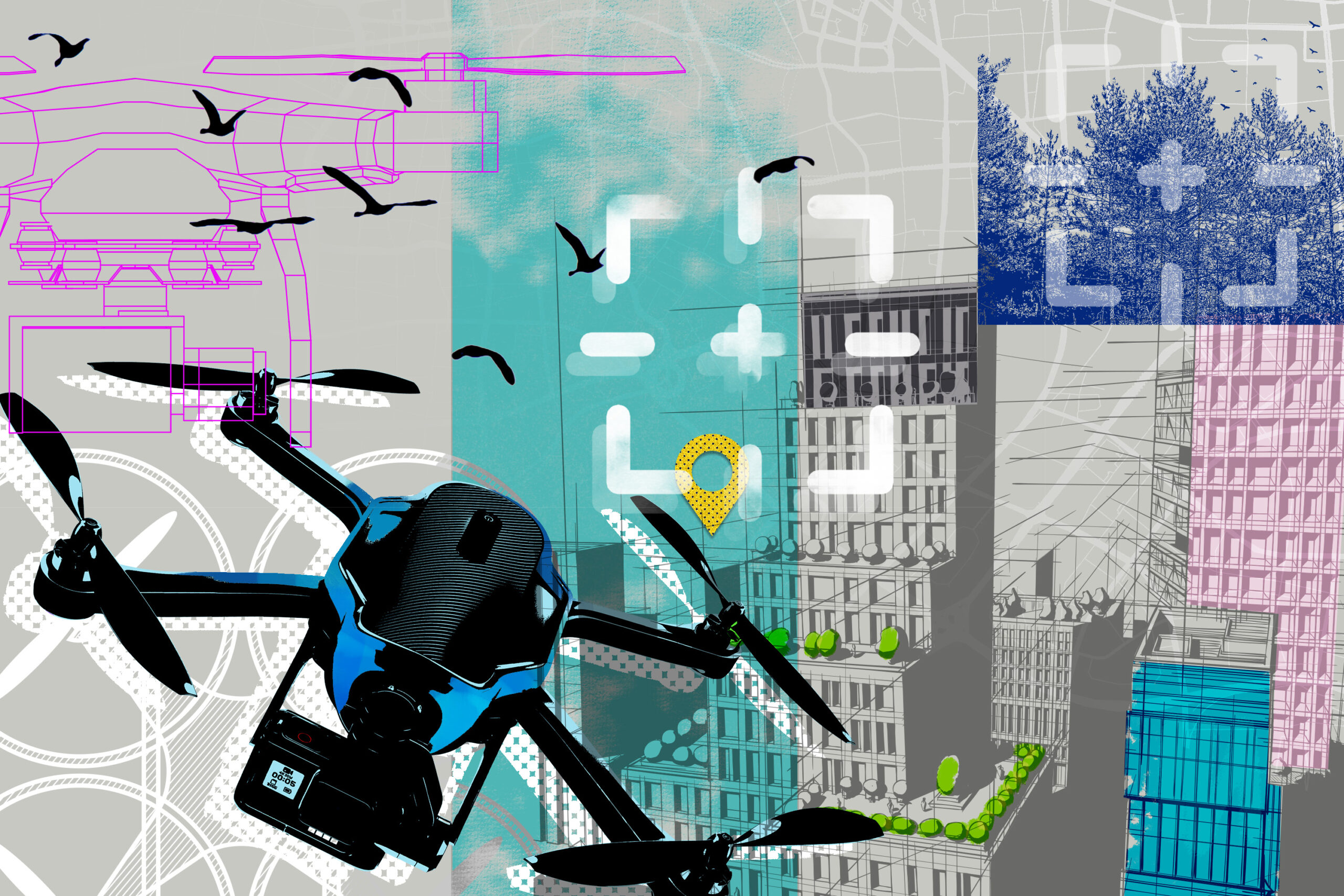Tech
Accounting for uncertainty to help engineers design complex systems

Designing a complex electronic device like a delivery drone involves juggling many choices, such as selecting motors and batteries that minimize cost while maximizing the payload the drone can carry or the distance it can travel.
Unraveling that conundrum is no easy task, but what happens if the designers don’t know the exact specifications of each battery and motor? On top of that, the real-world performance of these components will likely be affected by unpredictable factors, like changing weather along the drone’s route.
MIT researchers developed a new framework that helps engineers design complex systems in a way that explicitly accounts for such uncertainty. The framework allows them to model the performance tradeoffs of a device with many interconnected parts, each of which could behave in unpredictable ways.
Their technique captures the likelihood of many outcomes and tradeoffs, giving designers more information than many existing approaches which, at most, can usually only model best-case and worst-case scenarios.
Ultimately, this framework could help engineers develop complex systems like autonomous vehicles, commercial aircraft, or even regional transportation networks that are more robust and reliable in the face of real-world unpredictability.
“In practice, the components in a device never behave exactly like you think they will. If someone has a sensor whose performance is uncertain, and an algorithm that is uncertain, and the design of a robot that is also uncertain, now they have a way to mix all these uncertainties together so they can come up with a better design,” says Gioele Zardini, the Rudge and Nancy Allen Assistant Professor of Civil and Environmental Engineering at MIT, a principal investigator in the Laboratory for Information and Decision Systems (LIDS), an affiliate faculty with the Institute for Data, Systems, and Society (IDSS), and senior author of a paper on this framework.
Zardini is joined on the paper by lead author Yujun Huang, an MIT graduate student; and Marius Furter, a graduate student at the University of Zurich. The research will be presented at the IEEE Conference on Decision and Control.
Considering uncertainty
The Zardini Group studies co-design, a method for designing systems made of many interconnected components, from robots to regional transportation networks.
The co-design language breaks a complex problem into a series of boxes, each representing one component, that can be combined in different ways to maximize outcomes or minimize costs. This allows engineers to solve complex problems in a feasible amount of time.
In prior work, the researchers modeled each co-design component without considering uncertainty. For instance, the performance of each sensor the designers could choose for a drone was fixed.
But engineers often don’t know the exact performance specifications of each sensor, and even if they do, it is unlikely the senor will perfectly follow its spec sheet. At the same time, they don’t know how each sensor will behave once integrated into a complex device, or how performance will be affected by unpredictable factors like weather.
“With our method, even if you are unsure what the specifications of your sensor will be, you can still design the robot to maximize the outcome you care about,” says Furter.
To accomplish this, the researchers incorporated this notion of uncertainty into an existing framework based on category theory.
Using some mathematical tricks, they simplified the problem into a more general structure. This allows them to use the tools of category theory to solve co-design problems in a way that considers a range of uncertain outcomes.
By reformulating the problem, the researchers can capture how multiple design choices affect one another even when their individual performance is uncertain.
This approach is also simpler than many existing tools that typically require extensive domain expertise. With their plug-and-play system, one can rearrange the components in the system without violating any mathematical constraints.
And because no specific domain expertise is required, the framework could be used by a multidisciplinary team where each member designs one component of a larger system.
“Designing an entire UAV isn’t feasible for just one person, but designing a component of a UAV is. By providing the framework for how these components work together in a way that considers uncertainty, we’ve made it easier for people to evaluate the performance of the entire UAV system,” Huang says.
More detailed information
The researchers used this new approach to choose perception systems and batteries for a drone that would maximize its payload while minimizing its lifetime cost and weight.
While each perception system may offer a different detection accuracy under varying weather conditions, the designer doesn’t know exactly how its performance will fluctuate. This new system allows the designer to take these uncertainties into consideration when thinking about the drone’s overall performance.
And unlike other approaches, their framework reveals distinct advantages of each battery technology.
For instance, their results show that at lower payloads, nickel-metal hydride batteries provide the lowest expected lifetime cost. This insight would be impossible to fully capture without accounting for uncertainty, Zardini says.
While another method might only be able to show the best-case and worst-case performance scenarios of lithium polymer batteries, their framework gives the user more detailed information.
For example, it shows that if the drone’s payload is 1,750 grams, there is a 12.8 percent chance the battery design would be infeasible.
“Our system provides the tradeoffs, and then the user can reason about the design,” he adds.
In the future, the researchers want to improve the computational efficiency of their problem-solving algorithms. They also want to extend this approach to situations where a system is designed by multiple parties that are collaborative and competitive, like a transportation network in which rail companies operate using the same infrastructure.
“As the complexity of systems grow, and involves more disparate components, we need a formal framework in which to design these systems. This paper presents a way to compose large systems from modular components, understand design trade-offs, and importantly do so with a notion of uncertainty. This creates an opportunity to formalize the design of large-scale systems with learning-enabled components,” says Aaron Ames, the Bren Professor of Mechanical and Civil Engineering, Control and Dynamical Systems, and Aerospace at Caltech, who was not involved with this research.
Tech
Squarespace Promo Codes: 10% Off November 2025

Squarespace helps small businesses and regular Joe Schmoes to get software help to build their own websites (for both personal and business), even including the commerce side of things with point of sale, inventory, and customer data features (both online or in person). In the age where literally everything is digitized and accessed through the World Wide Web, having an online presence is the most important thing you can do for your business or brand’s growth. Creating a website can be difficult, with the HTMLs and coding and what not—that’s where Squarespace comes in. And we’ve found some of the best Squarespace discounts to help you save while growing your business.
Get 10% Off With This Exclusive Squarespace Promo Code
One of the best things about Squarespace is the versatility of it—compared to other website builders, it’s hard to beat in terms of the large number of layout options, user-friendly interface, and the various features available. Some of those features include built-in ecommerce capabilities (for those hoping to sell their work), promotion marketing tools, and booking and appointment handling. WIRED even named Squarespace one of the best websites to show off your portfolio of work. Right now, first-time users can get 10% off any website or domain plan, plus a 2 week free trial period. All you need to do is click the coupon above and enter the Squarespace promo code at checkout to get the deal.
Use Squarespace Promo Code to Save on a New Website or Domain
Once you find the plan you want—the Squarespace coupon is valid on any plan—enter the Squarespace discount code. Enter the Squarespace promo code WIRED10 into the box at checkout to see the savings roll in.
Save up to 36% on Squarespace Plans
Squarespace continues to reign at the top of our list of the best website builders, with features and customizable templates that help any skill level design like a pro. But don’t just take our word, users can start with a free 14-day trial and then make a decision on which plan best suits their personal or business’ needs. Squarespace frequently releases discount codes for 20% off new websites, but forget needing one–the easiest way to save is through an annual plan, which on average saves around 28-36% by locking in an annual price rather than a pay-as-you-go model with the monthly plan. You’ll need your business to have a website for longevity, so I’d recommend buying long term and saving big.
Prices per plan range, with the basic at $16 per month for 36% off with the yearly plan, Core at $23 per month for 36% off, and Plus at $39 per month for 30% off. The Advanced plan is $99 per month at 28% off—this includes features from cheaper plans, and also has the lowest payment processing fees, improved CSS, and JavaScript customization.
Students Get a 50% Off Squarespace Discount Code
Like Millennials and Gen Z-ers, Squarespace knows just how important our digital footprint is in this day and age. That’s why Squarespace is offering a student discount, where students can get 50% off annual plans to help launch their burgeoning business. All you need to do to get the Squarespace coupon code is verify your student status with Student Beans. Once you’ve verified using the free service, just input the offer code during checkout. Note: authorized students can obtain only one code every 12 months, whether the offer code is redeemed or not.
20% Off for Squarespace Circle Customers
Squarespace Circle perks is how people can get rewarded for using the platform. To join, users must have three Squarespace websites already. There are tons of perks for any small biz owner using Squarespace Circle, including: commission for bringing new folks to Squarespace, a 20% discount on new website subscriptions when you reach Platinum status, 20% off new annual email campaigns and scheduling subscriptions, a six-month free trial, priority customer support, educational resources and more. Although the benefits are tiered based on the number of websites you publish, the free option of Circle offers a 10% discount on annual plans, 3 month free trials, and early access to news on product launches. Check out the links above to see if Squarespace Circle would be a good fit for you (or your business).
Check Out the New Squarespace AI Website Builder
AI is everywhere, and here at WIRED, we know it all too well. Squarespace is jumping on the AI bandwagon, with its new Blueprint AI service, which helps you smartly build your website. It’s free to use, although you need a paid Squarespace account to publish any website you create with Blueprint AI. If that’s not your jam and you prefer to go a little more old school, you can browse pre-built website templates, including specific designs optimized for various business focuses and needs.
Squarespace is one of the most versatile and user-friendly website builders out there, and with WIRED’s Squarespace discount code, you can save 10% on any plan.
Get 20% Off Squarespace Acuity Scheduling (Or Try it for Free)
Squarespace Acuity Scheduling is an online scheduling solution for your business that completes annoying (but necessary) administrative tasks like calendar syncing, automated email and text message reminders, payment processor integrations, and more.
Plus, you don’t even need a Squarespace website to use Acuity. It includes a separate scheduling page clients can visit to book appointments, and you can embed your Acuity scheduler in almost any website. Then, if you decide to add a website from Squarespace, it’s super easy to use Squarespace’s tools and pre-designed templates. They make it easy, with a free trial option that requires no website or credit card. If you decide on a plan, you’ll save 20% annually on Starter and Standard, and19% off Premium.
Tech
Europe tackles e-waste with eco-friendly innovation that helps reuse and repair

Researchers are developing reusable and environmentally friendly electronics for the health care, consumer and manufacturing sectors, replacing scarce materials with circular alternatives to build a sustainable future.
Europe’s appetite for electronics keeps growing, but so does the waste. From smartphones and laptops to medical sensors, more devices mean mounting piles of discarded hardware.
According to Eurostat, around 5 million metric tons of electronic waste is collected for recycling in the EU each year. That is more than 11 kilograms per household, enough to cover around 2,000 football pitches stacked a meter high.
These 5 million metric tons represent less than 40% of the total mass of electronics put on the European market annually. The rest often ends up in landfills because mixed materials make recycling difficult.
Smarter design
To tackle this challenge, the SUSTRONICS initiative is rethinking how electronics are made, from the materials used to the way products are assembled and repaired. Led by Dutch technology company Philips, it brings together 46 partners from 11 countries. The three-year initiative runs until May 2026.
“The SUSTRONICS researchers focus mainly on fundamental research into new solutions,” explained Ramon Caanen, who leads a sustainability consulting team at Philips.
This includes the use of bio-based, paper-based and more widely available materials, the sustainable manufacturing of electronic components as well as designs that enable better recycling.
The researchers’ goal is to embed sustainability into design, production and functionality, so that products can be better reused and more easily recycled.
That focus has gained urgency since the EU introduced new regulations on eco-design and the right to repair in 2024. They are meant to extend product lifespans, improve energy efficiency and make repairs simpler. They also aim to reduce environmental impact and promote a more circular economy with less waste.
Health care pilots
Health care is one of SUSTRONICS’s main proving grounds. While connected medical devices can improve patient care, their single-use electronic parts add to the e-waste problem. Three pilot studies are developing sustainable electronics for health care.
At Swedish hygiene company Essity Hygiene and Health, a partner in the global research, principal scientist Shabira Abbas is working on a smart incontinence pad designed to make life easier for both patients and staff.
The device is known as a change indicator and alerts staff when a pad needs replacing. A small clip-on reader sits outside the pad, is cleaned between patients, and is reused with each new pad.
“It is designed to improve both skin health and dignity,” said Abbas.
A removable electronic strip inside the pad measures temperature, humidity and enzymes. It can be recycled separately where facilities allow. The team uses paper substrates and 3D-printed metal-oxide sensors to reduce the use of material.
The pad also requires a small reader, which sits outside the pad, to transmit data to staff. This clip-on reader can be reused with each new pad.
“In between patients, you have to clean the reader, but otherwise they are reusable,” said Abbas. Her team’s challenge is making the connector foolproof and easy for staff to attach and remove.
They are also working on energy efficiency, adapting software to use minimal power while processing pad data. This is vital for medical devices that must run continuously, since the combined energy demand of many units greatly increases their overall carbon footprint.
The other two pilot devices include a skin patch for tracking glucose metabolism and a smart dressing for wounds, which signals when it needs replacing. In today’s medical practice, both are still single-use, so sustainability is a key challenge.
Better materials
The SUSTRONICS team is also exploring ways to improve production efficiency and use recyclable or environmentally friendly materials whenever possible. Part of the solution is moving to more common resources from those that are scarce and environmentally harmful, such as silver.
“Silver has a high upstream footprint. Replacing silver with more common materials such as copper or carbon can lower impact significantly. But the key challenge is to make these substitutes perform well in their intended electronics application,” said Caanen.
Beyond medical devices, pilots also target repairability in shavers and lighting, easier dismantling for recycling, and lower energy use.
Looking ahead
Their work ties in with wider EU goals. A new Circular Economy Act, expected in 2026, will create a stronger market for recycled materials, boosting both supply and demand across Europe. It supports the EU’s ambition to lead the world in circular economy practices by 2030.
Today, only about 12% of Europe’s materials are reused or recycled. The target is to double this to 24% by 2030 under the EU’s Clean Industrial Deal.
Caanen hopes that SUSTRONICS will become a flagship project for sustainable electronics, by demonstrating how the European electronics industry can benefit from sustainable, alternative materials for electronic components, while maintaining competitiveness.
For hospital patients, innovations like the smart pad could mean greater comfort, dignity and quality of care, while also contributing to a more sustainable, circular economy.
By combining practical health care solutions with ambitious environmental goals, the SUSTRONICS team demonstrates how technological innovation can improve everyday lives and support Europe’s drive for sustainability.
In the long term, such efforts could transform both the electronics industry and health care, showing that small devices can have a big impact.
Citation:
Europe tackles e-waste with eco-friendly innovation that helps reuse and repair (2025, November 17)
retrieved 17 November 2025
from https://techxplore.com/news/2025-11-europe-tackles-eco-friendly-reuse.html
This document is subject to copyright. Apart from any fair dealing for the purpose of private study or research, no
part may be reproduced without the written permission. The content is provided for information purposes only.
Tech
WIRED Roundup: Fandom in Politics, Zuckerberg’s Illegal School, and Nepal’s Discord Revolution

Leah Feiger: Zoë, I am obsessed with this story. Before you continue, I think that it’s really important to say that Caroline, the lovely reporter of this story on your business desk, obtained 1,665 pages of documents about the dispute about Zuckerberg’s house. This story is canon now.
Zoë Schiffer: Caroline Haskins is a complete star. Our fact-checking team literally cried when I asked them. They were like, “Wait, sorry, how many documents are we looking through?” I was like, “Yes.”
Leah Feiger: Shout out to the WIRED research team.
Zoë Schiffer: Absolutely. The school, I think we just have to say, is named after one of the Zuckerberg family chickens. It’s called the Bicken Ben School.
Leah Feiger: I mean, hearing you say this, it’s, I know you’re being serious, but again.
Zoë Schiffer: So, the Crescent City neighborhood in Palo Alto, where the Zuckerbergs live, as you can imagine, is some of the best real estate in the entire country. It’s filled with these gorgeous homes, a ton of greenery. Mark Zuckerberg has been expanding his presence throughout the years in this ultra fancy neighborhood. The plot of land that the Zuckerbergs live on has expanded to include 11 previously separate properties. This is so funny and just such a nightmare. If you’re living on the street, you paid whatever, $5 million for your house, and suddenly all of your neighbors are Mark Zuckerberg.
Leah Feiger: Important to note that not all of them are connecting either. I don’t totally understand what that means. Do they walk through a neighbor’s porch to get to their horse’s pool? What does this entail?
Zoë Schiffer: We have more questions. We have to Google Earth this. I think there’s some holes in this story that we need to fill in. The expansion first became a concern for Mark Zuckerberg’s neighbors, back in 2016, due to fears that his purchases were driving up the market pretty dramatically. But then, about five years later, neighbors started noticing that a school appeared to be operating out of the Zuckerberg compound. So, this is illegal to do without a permit, at least under the area’s residential zoning code. And so, naturally, the neighbors started to alert the city. Caroline Haskins, the reporter on the story, obtained over a thousand documents, like you said, outlining the resulting fight between the neighbors and the city authorities, basically arguing that, it felt to them like the Zuckerbergs were getting special treatment.
-

 Tech1 week ago
Tech1 week agoFrom waste to asset: Turning ethanol production CO₂ into jet fuel
-

 Tech3 days ago
Tech3 days agoNew carbon capture method uses water and pressure to remove CO₂ from emissions at half current costs
-

 Politics4 days ago
Politics4 days agoBritish-Pakistani honoured for transforming UK halal meat industry
-

 Sports2 days ago
Sports2 days agoTexas A&M officer scolds South Carolina wide receiver after touchdown; department speaks out
-
Sports1 week ago
College football winners and losers: The catch of the year saves Indiana
-

 Tech1 week ago
Tech1 week agoSecurity flaws in portable genetic sequencers risk leaking private DNA data
-

 Politics5 days ago
Politics5 days agoInternet freedom declines in US, Germany amid growing online restrictions
-

 Fashion4 days ago
Fashion4 days agoAfter London, Leeds and Newcastle, next stop Glasgow for busy Omnes





